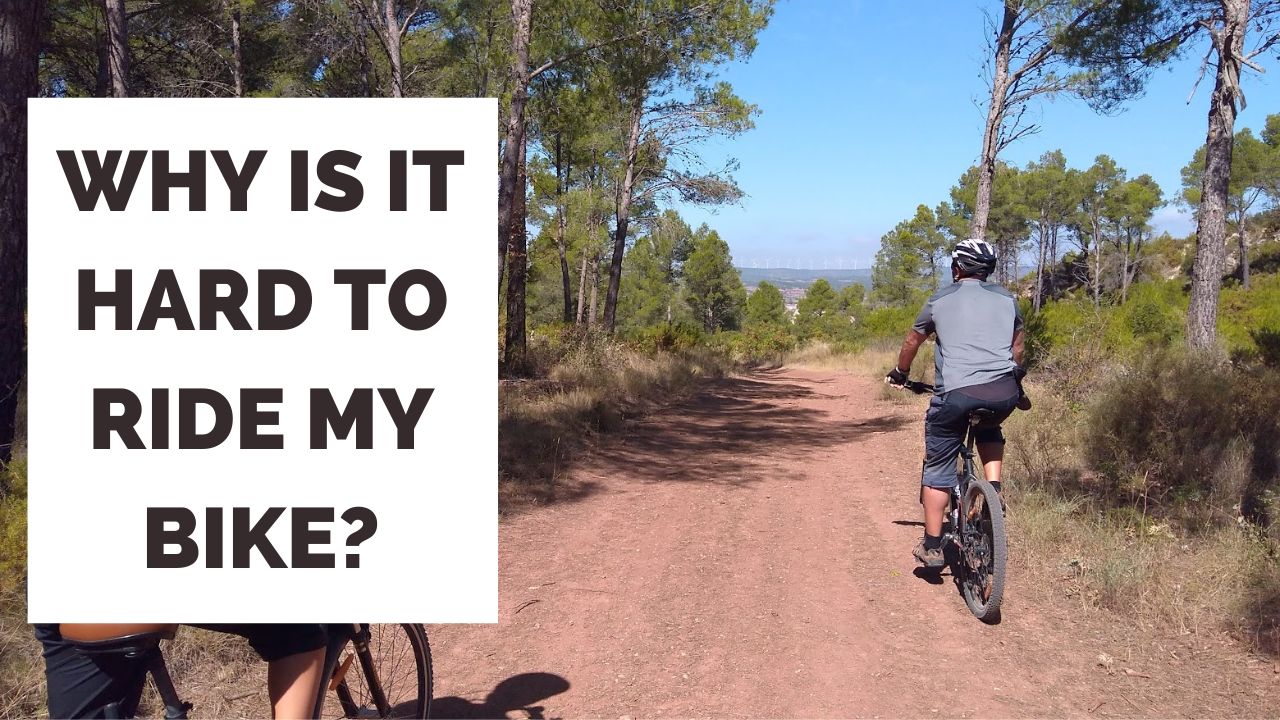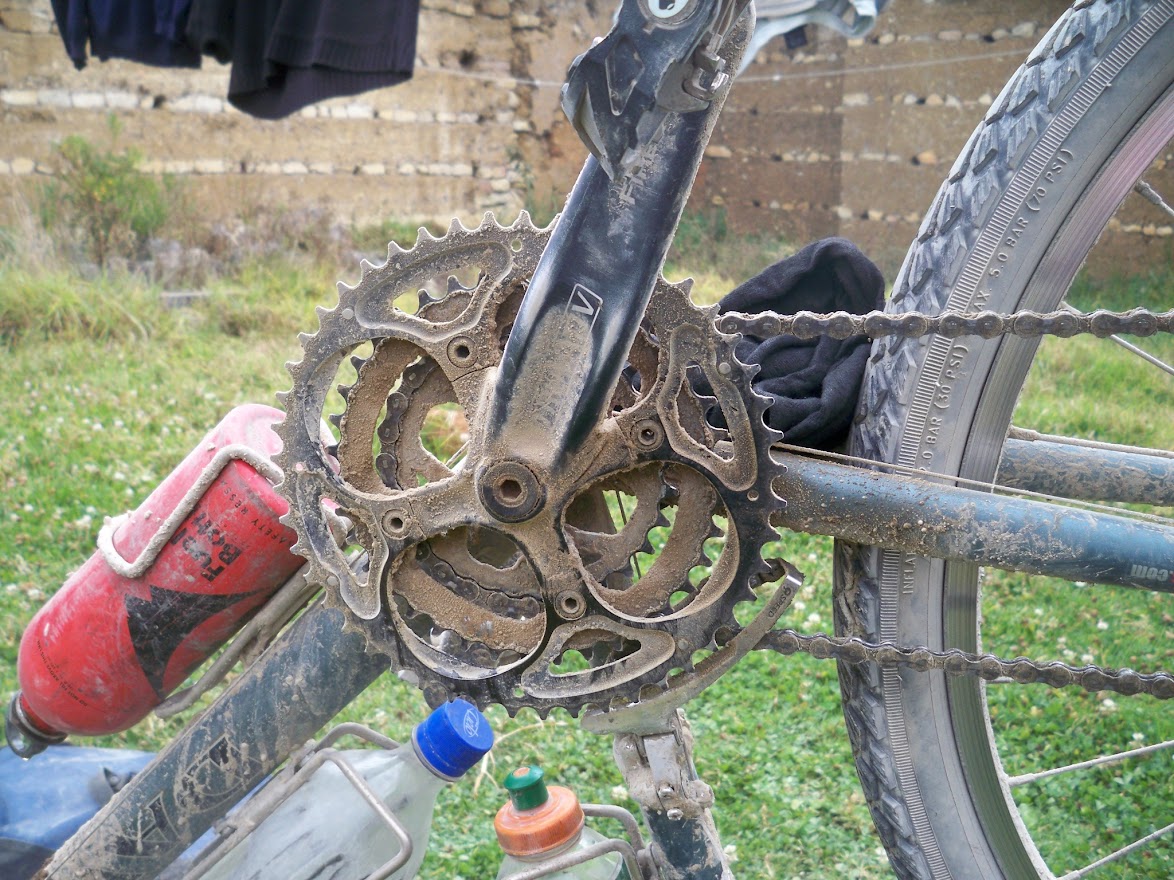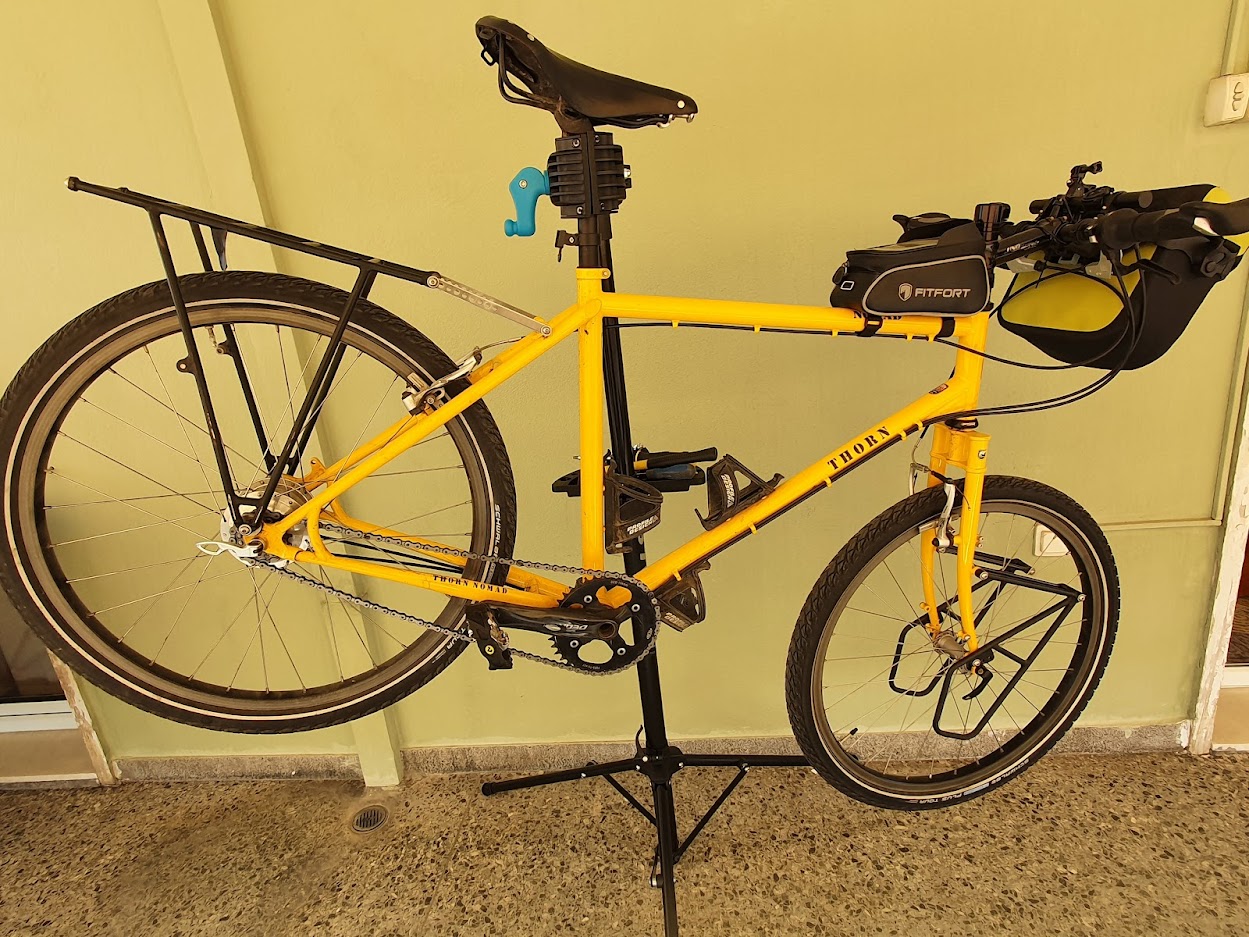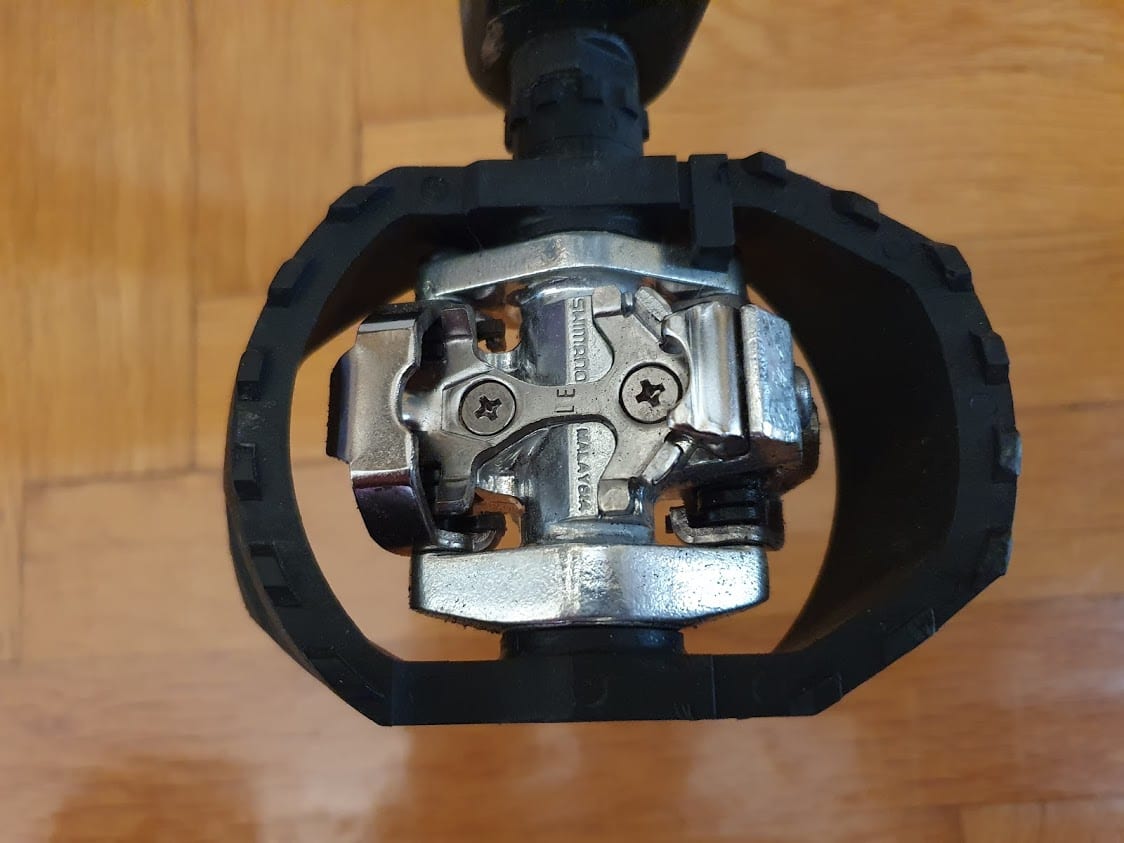If your bike feels hard to pedal, the most likely reason is the wheel rubbing against the frame or brake-pad. There are other things to look for as well, including reason 9 on the list – which maybe you don't want to admit!

Finding it hard pedaling your bike?
Whether you just took your bike out of the garage for the first time this season and noticed it's a lot harder to pedal than it was last year, or you are a regular cyclist who has started to notice some unusual resistance when pedaling, it comes down to one thing – friction.
The definition of friction is the resistance that one object has when moving over the surface of another.
When it comes to cycling, you have several potential friction points due to the number of moving parts. If you can reduce the amount of friction, the bicycle will be smoother to ride – that's why a well oiled chain is a good idea!
Related: Why does my chain keep falling off
When trying to work out why your bike is harder to pedal than it used to be, we can start by looking at these friction points to see if anything is wrong.
1. Bicycle Wheel Rubbing Against Frame, Brake-Pad, or Fender
Whenever I think it's getting harder to pedal my bike, the first thing I look at are the wheels. If I am out on the road, I lift the bike up by the handlebars and give the front wheel a spin. The wheel should spin freely, with no sound of rubbing against brake pads. I then lift the bike up by the seat post, and do the same thing with the rear wheel.
Related: Why does my bike wheel wobble?
Out of true wheels on a bicycle tend to spin with a slight wobble. Wheels with broken spokes do the same. As they do this, they rub against the rim brakes causing friction. It could be a matter of adjusting your brake pads, or you might need to replace a spoke or re-true your bike wheel.
I've also seen rear wheels in particular tightened up too much with the quick release skewer. I've also seen the rear wheels of bikes put on not centrally which cause frame rubbing.
A note about fenders: When bike touring in Alaska, I noticed my wheels were rubbing against the fenders which was increasing the resistance. In addition, on muddy roads, mud started to build up between the fenders and tires which on extreme muddy roads stopped the wheels from spinning totally!
In the end, I removed the fenders from my touring bike – Maybe not a popular choice for some cyclists but it worked for me!
Related: Disc brakes vs rim brakes
2. Your Tires Have Low Pressure
If your bike wheels turn smoothly, you could still have a problem with the tires if you have low air pressure. While in some circumstances (such as using a mountain bike on rough roads) it can be useful to have lower air pressure than normal, it does increase the rolling resistance.
I recommend always taking a bike pump with an air pressure gauge so you can take the guess work out of whether or not your tires are inflated to the optimal pressure.
If your tire pressure is really low, you might have a slow puncture or a flat tire. Check the tire for anything sticking into it, and use a puncture repair kit if needed.
In addition, if your inner tube is literally years old, you might never find the cause of the slow puncture (it could be the valve). Simply replace the inner tube.
Related: Difference Between Presta And Schrader Valves
3. Your Chain Needs Lubrication And Cleaning
I've already mentioned this, but a well lubricated chain will decrease the amount of friction and make your bike easier to pedal. It can be surprising how “I put some oil on the chain last week” turns into “wow, is it really a months since I cleaned the chain?!”.
Try to keep to a maintenance schedule of cleaning and lubricating your chain every few weeks.
If you live in a particularly wet or sandy area, you might need to clean your chain more frequently. You can use a bicycle chain cleaning tool to make the job easier.

4. Your Chain Needs Replacing
If your bike chain is loose or damaged, it can also lead to more effort needed to cycle. This is because a loose or damaged chain can cause the gears to slip when you're pedaling, which makes it difficult to move forward.
If your chain is loose, tightening it might solve the problem. However, if the chain is very old or damaged, you'll need to replace it before you'll be able to ride with less effort again! There's no point in trying to make a rusty chain more serviceable – just replace it and you'll find your riding got a whole lot easier.
5. There's A Problem With The Derailleur or Gears
The derailleur is responsible for moving the chain from one gear to another as you shift gears on your road bike. If there's a problem with the derailleur, it can cause the chain to become stuck or misaligned, which will make biking harder than usual. To fix this problem with the drive train system, you'll need to start looking at indexing the gears.
The cable tension on your derailleur might also be off, causing the gears to slip. This is a relatively easy fix that you can do at home with a bike multi-tool, however your gear cable might need replacing if it has become too worn.
If your bike hasn't been used for a while, you might even be stuck in one gear, which then makes pedaling very difficult. In fact, if you haven't been on a bike for a while, it might simply be a case of choosing an easier gear to cycle in!

6. There's Something Wrong With The Bottom Bracket
No one likes problems with bottom brackets, but if you've started hearing grinding sounds from strange places, then it might be time to investigate. The bottom bracket is what the pedals attach to and if there's something wrong with it, then you're going to have a lot of trouble pedaling.
To fix this problem, you'll need to remove the bottom bracket and take a close look at it. If there's any damage, you might need a trip to a bike shop.
7. Bike Seat At Wrong Height
The saddle height plays an important role in the comfort and pedaling efficiency. If your bike seat is too low, you'll find it difficult to pedal because you won't have enough power going through the pedals. This makes it harder to get up hills and can even cause knee pain.
On the other hand, if your saddle is too high, you might find yourself rocking back and forth on the saddle, which is not only inefficient but can also be dangerous.
Setting a correct seat height will improve your overall cycling efficiency and make it easier to pedal.
8. Try using SPD Pedals
SPD pedals are a type of bike pedal that's designed to increase pedaling efficiency. They do this by providing a more stable platform for your foot to push against when you're pedaling, which makes it easier to transfer power to the pedals.
They also allow you to pull upwards on each pedal stroke, which helps you to generate more power by using more muscles in your leg.

9. It's Not The Bike, It's You
You might not want to hear this, but sometimes the problem isn't with the bike at all – it's with the rider! If you're not used to cycling, then it's only natural that you'll find it harder to pedal than someone who cycles regularly. If it's been years since you last cycled, you can't expect to be able to ride like you used to.
The best way to get better at cycling is to simply keep riding and pedaling as much as you can. The more you do it, the easier it will become. Just make sure you take it easy at first and build up your mileage gradually. Throw in a few hill days for extra workouts, and you'll be turning those pedals easier than ever before!
Other Reasons You Might Find It Hard To Cycle
A few other reasons you might be struggling to turn those pedals include:
- You're cycling uphill – you just didn't really realise it
- Too much weight on the bike – common when bike touring!
- Weight not distributed evenly on the bicycle – again another bike touring problem
- Gravel roads are harder to ride on than smooth roads
FAQ About Cycling Easier
People who find their bikes hard to pedal also ask questions such as:
How do I make my bike pedal easier?
Assuming that your bike is in perfect working order, the simplest way to pedal easier is to choose a lower gear. While you may spin the pedals more times per minute, you'll find it much easier to turn them.
How do you fix a stiff pedal on a bike?
Clean away and dirt and grime, and use some grease when you attach the pedals to the wheel crank. In some cases, the bearing balls may have come loose. This might mean you need new pedals.
Why does my bike feel sluggish?
The most common reasons you might find it hard to pedal your bike are that you are in the wrong gear, your tire pressure is too low, or the bike wheels are rubbing against the brake pads or frame.
How often should I replace a bike chain?
On regular bikes, you can expect to get 2000 or 3000 miles out of a chain before it needs replacing. With Rohloff hub geared bikes with an eccentric bottom bracket, you might get twice or even three times that.
You might also want to read these other bicycle troubleshooting guides:
- Where to clamp your bike on a repair stand
- Why is my bike pump not working?
- How to stop my bicycle rack wobbling?
- How to stop a bike rusting outside
 Article Author- Dave Briggs
Article Author- Dave Briggs
Dave has cycled around much of the world, including multi-year bicycle touring trips such as Alaska to Argentina, and England to South Africa. Check out more of his reviews and tips about bike touring.
Follow Dave on social media for travel, adventure and bike touring inspiration:
my pedals have me struggling of late as they are not St tight angle now so my feet are slipping on them. help. I hope to fix them not replacing.
Sounds like you have loose or badly fitted pedals? Suggest removing them, putting a bit of grease on the threads, and putting the pedals back on.